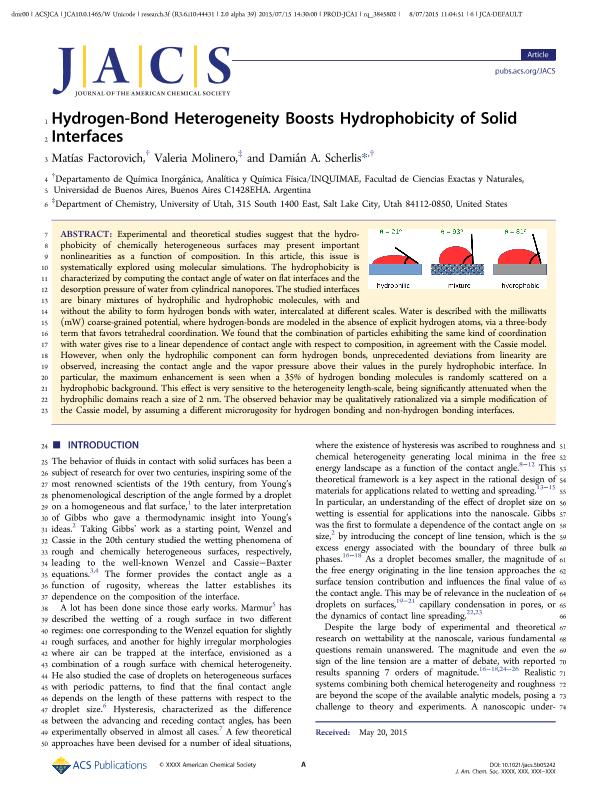Artículo
Hydrogen-Bond Heterogeneity Boosts Hydrophobicity of Solid Interfaces
Fecha de publicación:
08/2015
Editorial:
American Chemical Society
Revista:
Journal of the American Chemical Society
ISSN:
0002-7863
Idioma:
Inglés
Tipo de recurso:
Artículo publicado
Clasificación temática:
Resumen
Experimental and theoretical studies suggest that the hydrophobicity of chemically heterogeneous surfaces may present important nonlinearities as a function of composition. In this article, this issue is systematically explored using molecular simulations. The hydrophobicity is characterized by computing the contact angle of water on flat interfaces and the desorption pressure of water from cylindrical nanopores. The studied interfaces are binary mixtures of hydrophilic and hydrophobic sites, with and without the ability to form hydrogen bonds with water, intercalated at different scales. Water is described with the mW coarse-grained potential, where hydrogen-bonds are modeled in the absence of explicit hydrogen atoms, via a three-body term that favors tetrahedral coordination. We found that the combination of particles exhibiting the same kind of coordination with water gives rise to a linear dependence of contact angle with respect to composition, in agreement with the Cassie model. However, when only the hydrophilic component can form hydrogen bonds, unprecedented deviations from linearity are observed, increasing the contact angle and the vapor pressure above their values in the purely hydrophobic interface. In particular, the maximum enhancement is seen when a 35% of hydrogen bonding molecules is randomly scattered on a hydrophobic background. This effect is very sensitive to the heterogeneity length-scale, being significantly attenuated when the hydrophilic domains reach a size of 2 nm. The observed behavior may be qualitatively rationalized via a simple modification of the Cassie model, by assuming a different microrugosity for hydrogen bonding and non-hydrogen bonding interfaces.
Palabras clave:
Contact Angle
,
Nanodroplet
,
Molecular Dynamics
,
Interfaces
Archivos asociados
Licencia
Identificadores
Colecciones
Articulos(INQUIMAE)
Articulos de INST.D/QUIM FIS D/L MATERIALES MEDIOAMB Y ENERGIA
Articulos de INST.D/QUIM FIS D/L MATERIALES MEDIOAMB Y ENERGIA
Citación
Factorovich, Matias Hector; Molinero, Valeria; Scherlis Perel, Damian Ariel; Hydrogen-Bond Heterogeneity Boosts Hydrophobicity of Solid Interfaces; American Chemical Society; Journal of the American Chemical Society; 137; 33; 8-2015; 10618-10623
Compartir
Altmétricas




